The etcher Félix Bracquemond was a towering figure in nineteenth-century French printmaking, a fact which was recognised when in 1900 he won the Grand prix de gravure at the Exposition Universelle in Paris. Over the course of a long career he worked in various styles, producing over 800 prints, but essentially he is one of those figures who form a bridge between the Barbizon School and the Impressionists, having close links with both groups. His discovery of the woodcuts of Hokusai in the late 1850s is often seen as the start of French Japonisme.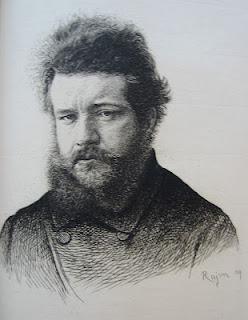 Paul Rajon, Bracquemond (en 1868)Etching, 1897
Paul Rajon, Bracquemond (en 1868)Etching, 1897
Félix Bracquemond was born Joseph Auguste Bracquemond in Paris in 1833. Brought up in a stable, he entertained youthful dreams of becoming a circus rider. Around 1848, he was instead apprenticed to a lithographer. Taking drawing lessons in the evenings, Bracquemond was noticed by Guichard, a former pupil of Ingres. He persuaded the boy's parents to let him leave his apprenticeship and become Guichard's pupil. Bracquemond made his debut at the Salon of 1852.
Félix Bracquemond was one of the pioneers and shapers of the French etching revival. It was Guichard encouraged him to learn etching, without being able to offer any practical help; undeterred, Bracquemond learned the techniques from an old encyclopedia. From 1862 Bracquemond was the driving force of the Société des Aquafortistes. Félix Bracquemond was generous with his advice and help to other artists who wanted to learn how to etch, including Corot, Courbet, Théodore Rousseau, Degas, and Fantin-Latour. Like most etchers and engravers of the time, Bracquemond earned his bread and butter by creating interpretative or reproductive etchings after the work of others. My first Bracquemond etching, dating from 1859, is one such piece, etched after a painting by the seventeenth-century Spanish painter Francisco Herrera the Elder. The second is a portrait of the artist Paul Chenavard, who like Guichard (and later Bracquemond's wife-to-be Marie Quiveron) was a pupil of Ingres; this may be after a photograph. The third is a portrait of the 18th-century artist Simon Mathurin Lantara, after a drawing by his friend Horace Vernet.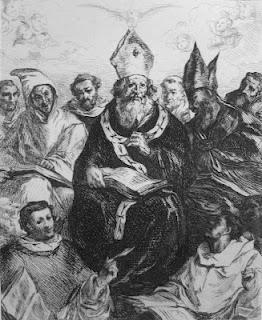 Félix Bracquemond, Saint Basile
Félix Bracquemond, Saint Basile
Etching, 1859, after a painting by Francisco Herrera the Elder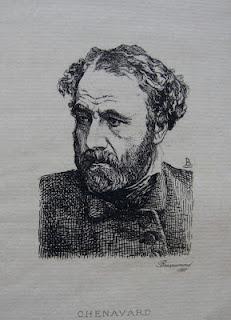 Félix Bracquemond, Paul ChenavardEtching, 1860
Félix Bracquemond, Paul ChenavardEtching, 1860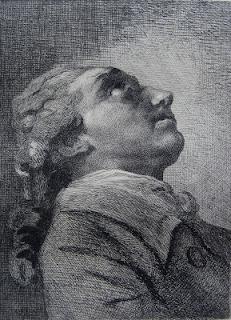 Félix Bracquemond, LantaraEtching, 1864, after a drawing by Horace Vernet
Félix Bracquemond, LantaraEtching, 1864, after a drawing by Horace Vernet
Because of his friendship with Impressionists such as Manet, Degas, Cassatt, and Caillebotte, Félix Bracquemond was invited to exhibit at the Impressionist Exhibitions of 1874 (the first), 1879, and 1880. At the First Impressionist Exhibition, Félix Bracquemond was I think the most prolific exhibitor, showing a total of 32 prints. He was joined in the 1879 and 1880 exhibitions by his wife Marie, who was one of the most significant female Impressionists, alongside Eva Gonzalès, Mary Cassatt, and Berthe Morisot (another pupil of Guichard). Marie Bracquemond also exhibited at the last Impressionist exhibition in 1886, this time without her husband. My next Bracquemond etching is an interpretative work after a painting by the Barbizon-linked painter Charles Chaplin, who taught both Mary Cassatt and Eva Gonzalès; Chaplin's atelier was the only place in Paris that accepted female students, apart from the Académie Julian.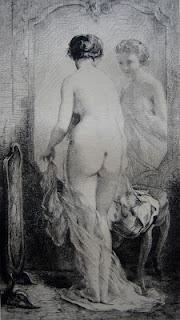 Félix Bracquemond, Le miroirEtching, 1867, after a painting by Charles Chaplin
Félix Bracquemond, Le miroirEtching, 1867, after a painting by Charles Chaplin
The Bracquemonds' son Pierre left a sour memoir full of resentment towards his father, whom he saw as domineering and unsympathetic. From this, the idea has gained currency that Félix Bracquemond stood in his wife's way, relentlessly criticising her and eventually bullying her into giving up her art. The current Wikipedia entry on Marie Bracquemond talks of, "his campaign to thwart her development as an artist," and says that "His objection to her art was not on the basis of gender but on the style she adopted, Impressionism." Later the article speaks of his "disgust" when Monet and Degas became her mentors. This is not just simplistic, but plain wrong. Félix Bracquemond was an early pioneer of Impressionism, as his 1868 series of 8 etchings, La Seine au Bas-Meudon, clearly shows. He was as keen as any of the Impressionists to capture the fleeting effects of light on the landscape, and even called some of his landscape studies of this period croquis impressionnistes. I wish I had one of these sparkling early Impressionist etchings to share with you.
Although no doubt Félix did have a strong and perhaps overbearing personality, and although his own devotion to the severe delights of black-and-white stands in opposition to Marie's lush sense of colour, the notion that he hated either her art or Impressionism in general is clearly nonsense. Not only did Félix exhibit with the Impressionists, he did so jointly with Marie. It was Félix who introduced her to Monet and to Degas, to Sisley who became one of their closest friends, to the art critic Gustave Geffroy, who championed her work, and to Paul Gauguin, who influenced her color sense profoundly. Here is what Félix actually had to say about Marie's art, as quoted by Jean-Paul Bouillon in his chapter on Marie Bracquemond in Pfeiffer and Hollein, Women Impressionists: "She has never turned out masses of work, preferring complete, properly finished pictures. And because she's sick and disheartened, her oeuvre is small. As a result, she's pushed aside as being useless. It's stupid and cruel."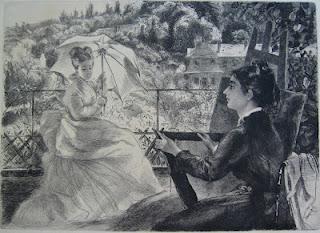 Félix Bracquemond, La terrasse de la Villa BrancasEtching, 1876, proof avant la lettre
Félix Bracquemond, La terrasse de la Villa BrancasEtching, 1876, proof avant la lettre
The most telling evidence of Félix's admiration and love for his wife lies in what I think is one of his finest etchings, La terrasse de la Villa Brancas, which was created in 1876, published by the revue L'Art in 1878, and exhibited at the 4th Impressionist Exhibition in 1879. It shows Marie on the terrace of their home in Sèvres, painting her sister Louis Quiveron, in the new Impressionist style she had adopted after the revelation of the First Impressionist Exhibition. Félix depicts his wife not as a mother, not as a domestic goddess, not as an object of male desire, but as an artist. Not just an artist, but an Impressionist artist, a fact which he conveys in his own style, which is the essence of Impressionism. Jean-Paul Bouillon writes vividly about the triumph of this etching: "In this major work . . . the artist takes a clear stand on the issue of color and plein air painting, demonstrating that the effect of light can be fully rendered, independently of color, simply by masterful gradation and ordering of black and white values, from pure white for Louise's dress and the parasol directly catching the sun, through the deep black of Marie's costume. And at the same time he informs us that in the mid-1870s his wife was already engaging with this kind of subject matter." One of Marie's greatest paintings, called alternatively Sur la terrasse à Sèvres or by the same title as the etching La terrasse de la Villa Brancas, is a kind of color riposte to the etching. It can be found in the Musée du Petit Palais in Geneva.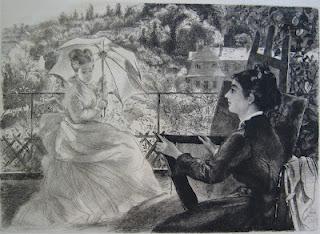 Félix Bracquemond, La terrasse de la Villa BrancasEtching, 1876
Félix Bracquemond, La terrasse de la Villa BrancasEtching, 1876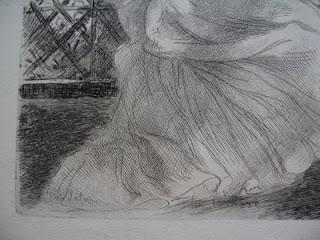
I'm delighted to be able to show you two versions of La terrasse de la Villa Brancas. The first is a rare proof avant la lettre, before Félix has used a drypoint needle to credit L'Art in the bottom righthand corner, the title La terrasse below Louise's dress, and a credit to the printer, A. Salmon, in the bottom left. I can't see any differences in the actual image, beyond the added lettering, but there may be some minor changes.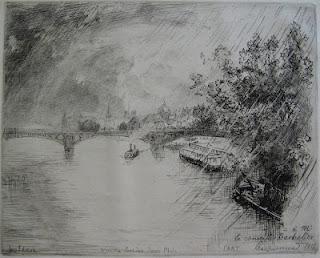 Félix Bracquemond, Vue du Pont des Saints-PèresEtching, 1877
Félix Bracquemond, Vue du Pont des Saints-PèresEtching, 1877
Vue du Pont des Saints-Pères is another notable Impressionist etching, also published by L'Art, while Les trembles, which shows the influence of Sisley, was published by the Gazette des Beaux-Arts, and La surprise by the Revue de l'art ancien et moderne. Stylistically I wonder if Les trembles, which depicts aspens quivering in the breeze on the banks of the Seine, may date from earlier than its publication date of 1884.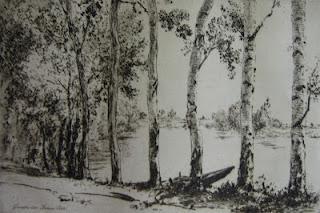 Félix Bracquemond, Les tremblesEtching, 1884
Félix Bracquemond, Les tremblesEtching, 1884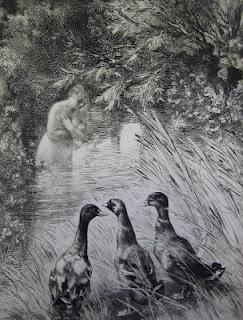 Félix Bracquemond, La surpriseEtching, 1900
Félix Bracquemond, La surpriseEtching, 1900
My next four etchings by Bracquemond were executed for a monumental work of 1895, La Mer by René Maizeroy, which contained 24 etchings by different hands. The first is the cover of the book, printed on thick buff-coloured paper. Félix Bracquemond, La MerEtching, 1895
Félix Bracquemond, La MerEtching, 1895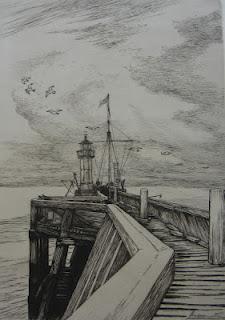 Félix Bracquemond, La Mer - frontispiceEtching, 1895
Félix Bracquemond, La Mer - frontispiceEtching, 1895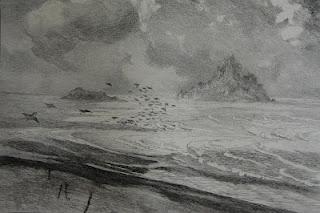 Félix Bracquemond, Le Mont Saint-MichelEtching, 1895
Félix Bracquemond, Le Mont Saint-MichelEtching, 1895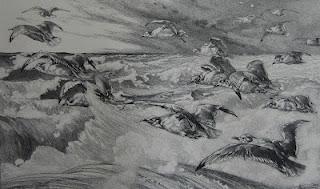 Félix Bracquemond, Les mouettesEtching, 1895
Félix Bracquemond, Les mouettesEtching, 1895
And finally, the last work I have from Bracquemond's hand, Loup dans la neige, or as it is titled in Zeitschrift für Bildende Kunst, Der Wulf im Schnee.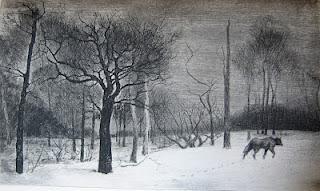 Félix Bracquemond, Loup dans la neigeEtching, 1907
Félix Bracquemond, Loup dans la neigeEtching, 1907
As well as his etchings and lithographs, Bracquemond designed ceramics, notably for Sèvres (from 1870) and Haviland, whose experimental atelier in Auteuil he ran as artistic director from 1872. The Sèvres porcelain factory can be seen in the background of La terrasse de la Villa Brancas. Loÿs Delteil, Bracquemond (en 1897)Etching, 1897
Loÿs Delteil, Bracquemond (en 1897)Etching, 1897
Félix Bracquemond died in Sèvres in 1914; Marie survived him by two years.

